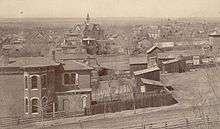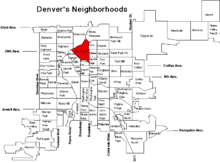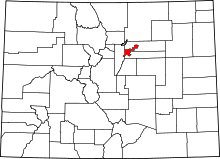Five Points, Denver
Five Points is one of Denver, Colorado's oldest neighborhoods. In the early 21st century, it is one of the fastest growing in terms of both redevelopment and population. Much of this growth is taking place in the River North Arts District, or "RiNo," which is often considered a neighborhood of its own, although it is officially within the Five Points neighborhood.
Five Points | |
|---|---|
Neighborhood | |
Light rail station at Five Points Plaza on Welton Street | |
| Country | United States of America |
| State | Colorado |
| City | Denver |
| Population (2010)[1] | |
| • Total | 12,712 |
| ZIP Codes | 80205, 80216 |
Geography
Five Points is on the northeast side of Downtown Denver's central business district. A small portion wraps around Coors Field and encompasses the Union Station North neighborhood (formerly Prospect).[2] This is where the downtown street grid meets the neighborhood street grid of the first Denver suburbs. The five points in the district's name refer to the vertices formed where four streets meet: 26th Avenue, 27th Street, Washington Street, and Welton Street. Five Points was the shortened name for the street car stop at this intersection.
History
Five Points came to historical prominence from the 1860s through the 1950s. The neighborhood was home to a number of Denver's leaders, housing mayors, governors, and prominent business people, as well as middle-class laborers. Rino, Prospect, Clement, Old San Rafael, Curtis Park, Arapahoe Square, and Ballpark neighborhoods are in the larger Five Points neighborhood.
With a succession of majority populations as new residents settled in the city, Five Points in the first half of the 20th century became known as the "Harlem of the West". It developed as a predominantly African-American neighborhood because discriminatory home sale laws in other areas excluded black people. African Americans migrated to the city, many first working for the railroad, which had a terminus here. They were part of the Great Migration of the 20th century out of the rural South to northern, midwestern and western industrial cities for jobs and other opportunities.
From the 1920s to the 1950s the community thrived, with a rich mix of business and commerce along the Welton Corridor. Businesses included a butcher, real estate companies, drug stores, tailors, restaurants, barbers, and many other main street services. Churches were also founded in the community.
Welton Street was also home to more than fifty bars and clubs, where nationally known jazz musicians, such as Billie Holiday, Duke Ellington, Miles Davis, Nat King Cole, Count Basie, Dizzy Gillespie and others performed. Black performers excluded from other hotels in Denver stayed at the Rossonian Hotel,[3] built in 1912. They also performed there and it became known as a famous music venue.

From the late 1950s through the late 1990s, the Five Points community suffered changes and decline as wealthier residents moved to newer housing in the postwar suburban boom. In addition, the growth of drugs was associated with crime and urban flight. Suburban housing and retail development drew many people out of the neighborhood. As the population declined, so did businesses, and many properties were abandoned. Redevelopment took place in other areas, as the larger market found local business conditions unappealing. Attempts at redevelopment were made, but there were many hindrances to reinvestment.
Five Points has long been a neighborhood with a diverse economic mix of residents, evidenced by the variety of houses there. Mansions were built next to row homes. Many of the rich began moving out of Five Points in the late 19th century to live in the more popular Capitol Hill neighborhood. Five Points at one time had a large Jewish population, formed by waves of immigration in the late 19th and early 20th centuries. A former synagogue, Temple Emanuel, stands on the corner of 24th and Curtis Street. The Jewish community founded Rose Hospital.
After World War II, many Japanese-Americans who had been interned in interior camps resettled in Denver and lived in Five Points. Agape Church on the corner of 25th Street and California Street was once a Japanese Methodist church.
In 2002 Five Points was designated as a cultural historic district, in recognition of its important role in African-American history in the city.[4]
In 2013, Sonny Lawson Park, at Park Avenue West and Welton, was renovated with completion of new ball field fencing and facilities, addition of exercise equipment, and improvements to the layout of the park.[5][6]
African-American history is recorded and exhibited at the Black American West Museum and Heritage Center and at the Blair-Caldwell African American Research Library. A number of African-American churches and businesses still operate in the community.
Demographics

At one period, when segregation was the law, an area centered around the Welton Corridor had an African American-majority population. But according to the Census, years of demographic change have brought about a majority white population (77 percent), a large Latino population (19 percent), with the black population at (14 percent).[7] In 2002 Five Points was designated as a cultural historic district, in recognition of its important role in African-American history in the city.[4]
Economy
In 2002, the Denver Housing Authority acquired a 100-year-old horse barn in the Curtis Park neighborhood near Five Points. Developer Andrew Romanoff was in charge of a renovation in 2012 to adapt the building for use as office space, to be leased to small businesses. It has since opened.[8]
Attempts to rebuild a strong business economy on Welton Street began in 2009 with the formation of the Five Points Business District.[9] The Five Points Business District has since ceased operations and funding was directed to a business improvement district.[10] The Rossonian Hotel at 2642 Welton Street is under going renovations.[11][4]
The residential average price per square foot as of May 2017 was $313.17.[12]
Arts and culture
Denver's Juneteenth festival draws thousands of people every year. A parade starts at Manual High School and goes down to Welton Street. Vendors sell merchandise and street performers entertain the crowd. The Five Points Jazz Festival takes place every May and celebrates the jazz history of the neighborhood. Stages are set up along Welton street, both inside the various music venues and on the street itself.[13]
Transportation
Five Points is well serviced by both bus and light rail.
In the early 1990s, Denver's first light rail system connected the downtown business district to Five Points.[14] A new transit stop was constructed at 38th and Blake in 2016 as part of the A Line. Nowadays Five Points is primarily served by the L Line, which was created by reworking parts of the already existing D Line.[15] One of the few remaining sections of Denver metro's RTD's FasTracks expansion plan is the final 0.8 miles of the L line. This section would connect the L line to the A line at the 38th & Blake station and include two new stations at 33rd and Downing and 35th and Downing.[16]
See also
References
- "Census Neighborhood Demographics (2010)". City of Denver.
- Alison Gregor (August 20, 2013). "In Denver, Beat Starts to Pick Up in a Once-Thriving Hub for Jazz". The New York Times. Retrieved January 18, 2015.
DENVER — At one time, the best place to hear live jazz between St. Louis and San Francisco was along Welton Street in Denver, where Duke and Ella were among the marquee legends stopping by to perform. Dozens of night spots and clubs dotted Welton Street in the predominantly African-American neighborhood of Five Points for more than half the 20th century, making it a premier destination that some called the Harlem of the West. The neighborhood’s rich heritage was recognized in 2002 through its designation as a cultural historic district. Its fragile history remains a living memory for some, and it has been commemorated with an archive at the local public library and in the literature of Jack Kerouac and the Beat Generation…..Carl Bourgeois, a property developer who owns the area’s star attraction, the now-empty Rossonian Hotel, where jazz greats would stay, has tried for three decades to revive the neighborhood. He and others point to the trove of historic buildings and landmarks, along with a light rail line, that should be spurring change.
- "Sonny Lawson Park looks to brighter future in Better Block Project". denverpost.com. Retrieved 15 November 2015.
- Patricia Calhoun. "The urban-camping ban doesn't solve the Bumuda Triangle problem". Westword. Retrieved 15 November 2015.
- Cheek, Tessa (December 10, 2013). "Global development hub finds home in historic Curtis Park horse barn". The Colorado Independent.
- Meltzer, Erica (June 1, 2016). "In Five Points business district, not everyone is sure this time's the charm". Denverite.
- Rubino, Joe (May 27, 2019). ""A new renaissance": African-American businesses, investors celebrating new era on Five Points' Welton Street". The Denver Post.
- Dodson, Andrew (April 22, 2019). "Take a sneak peek at plans for the bigger Rossonian Hotel redevelopment in Five Points". Denver Business Journal.
- "Five Points Neighborhood | Usaj Realty".
- https://www.artsandvenuesdenver.com/events-programs/five-points-jazz-festival/
- Bohlen, Teague (June 28, 2019). "Great Moments in RTD's Fifty-Year History". Westworld.
- Aguilar, John (January 13, 2018). "New RTD light rail line launching Sunday to boost service downtown and improve systemwide on-time performance, officials say". The Denver Post.
- http://www.rtd-fastracks.com/cc_1
